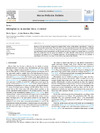Identificador persistente para citar o vincular este elemento:
https://accedacris.ulpgc.es/jspui/handle/10553/107382
| Campo DC | Valor | idioma |
|---|---|---|
| dc.contributor.author | Ugwu, Kevin | - |
| dc.contributor.author | Herrera Ulibarri, Alicia | - |
| dc.contributor.author | Gómez Cabrera, María Milagrosa | - |
| dc.date.accessioned | 2021-06-02T09:42:19Z | - |
| dc.date.available | 2021-06-02T09:42:19Z | - |
| dc.date.issued | 2021 | - |
| dc.identifier.issn | 0025-326X | - |
| dc.identifier.other | Scopus | - |
| dc.identifier.uri | https://accedacris.ulpgc.es/handle/10553/107382 | - |
| dc.description.abstract | Plastics are the most important component in marine debris. In turn, within plastics, microplastics (<5 mm) are those that most affect marine biota. Thus, this review has as its main objective to show the current state of studies of microplastics, as well as to determine the groups of vertebrates most affected by microplastics, and the type and predominant color of microplastics. For this research, we review a total of 132 articles, from 2010 to May of 2020. Our results show that the group more affected are turtles with 88% of the specimens contaminated by microplastics and median of 121.73 particles/individue. The predominant type is fibers (67.3%), polymer is polyethylene (27.3%), size is less than 2 mm (73.6%), and color is blue (32.9%). | - |
| dc.language | eng | - |
| dc.relation | Evaluación del impacto de microplásticos y contaminantes emergentes en las costas de la Macaronesia | - |
| dc.relation | Implementation of the indicator Impacts of marine litter on sea turtles and biota in RSC and MSFD areas | - |
| dc.relation.ispartof | Marine Pollution Bulletin | - |
| dc.source | Marine Pollution Bulletin [ISSN 0025-326X], v. 169, 112540 (Agosto 2021) | - |
| dc.subject | 251001 Oceanografía biológica | - |
| dc.subject | 240119 Zoología marina | - |
| dc.subject.other | Microplastics | - |
| dc.subject.other | Marine vertebrates | - |
| dc.subject.other | Turtles | - |
| dc.subject.other | Sea birds | - |
| dc.subject.other | Marine mammals | - |
| dc.subject.other | Fish | - |
| dc.title | Microplastics in marine biota: A review | - |
| dc.type | info:eu-repo/semantics/Article | - |
| dc.type | Article | - |
| dc.identifier.doi | 10.1016/j.marpolbul.2021.112540 | - |
| dc.identifier.scopus | 85107364761 | - |
| dc.contributor.orcid | NO DATA | - |
| dc.contributor.orcid | NO DATA | - |
| dc.contributor.orcid | NO DATA | - |
| dc.contributor.authorscopusid | 57224321704 | - |
| dc.contributor.authorscopusid | 57193161519 | - |
| dc.contributor.authorscopusid | 7401734371 | - |
| dc.identifier.eissn | 1879-3363 | - |
| dc.relation.volume | 169 | - |
| dc.investigacion | Ciencias | - |
| dc.type2 | Artículo | - |
| dc.description.numberofpages | 11 | - |
| dc.utils.revision | Sí | - |
| dc.date.coverdate | Agosto 2021 | - |
| dc.identifier.ulpgc | Sí | - |
| dc.contributor.buulpgc | BU-BAS | - |
| dc.description.sjr | 1,508 | |
| dc.description.jcr | 7,001 | |
| dc.description.sjrq | Q1 | |
| dc.description.jcrq | Q1 | |
| dc.description.scie | SCIE | |
| dc.description.miaricds | 11,0 | |
| item.fulltext | Con texto completo | - |
| item.grantfulltext | open | - |
| crisitem.author.dept | GIR ECOAQUA: Ecofisiología de Organismos Marinos | - |
| crisitem.author.dept | IU de Investigación en Acuicultura Sostenible y Ec | - |
| crisitem.author.dept | Departamento de Biología | - |
| crisitem.author.dept | GIR ECOAQUA: Ecofisiología de Organismos Marinos | - |
| crisitem.author.dept | IU de Investigación en Acuicultura Sostenible y Ec | - |
| crisitem.author.dept | Departamento de Biología | - |
| crisitem.author.orcid | 0000-0002-5538-6161 | - |
| crisitem.author.orcid | 0000-0002-7396-6493 | - |
| crisitem.author.parentorg | IU de Investigación en Acuicultura Sostenible y Ec | - |
| crisitem.author.parentorg | IU de Investigación en Acuicultura Sostenible y Ec | - |
| crisitem.author.fullName | Herrera Ulibarri, Alicia Andrea | - |
| crisitem.author.fullName | Gómez Cabrera, María Milagrosa | - |
| crisitem.project.principalinvestigator | Gómez Cabrera, María Milagrosa | - |
| crisitem.project.principalinvestigator | Gómez Cabrera, María Milagrosa | - |
| Colección: | Artículos | |
Citas SCOPUSTM
265
actualizado el 08-jun-2025
Citas de WEB OF SCIENCETM
Citations
225
actualizado el 08-jun-2025
Visitas
479
actualizado el 08-dic-2024
Descargas
402
actualizado el 08-dic-2024
Google ScholarTM
Verifica
Altmetric
Comparte
Exporta metadatos
Los elementos en ULPGC accedaCRIS están protegidos por derechos de autor con todos los derechos reservados, a menos que se indique lo contrario.
